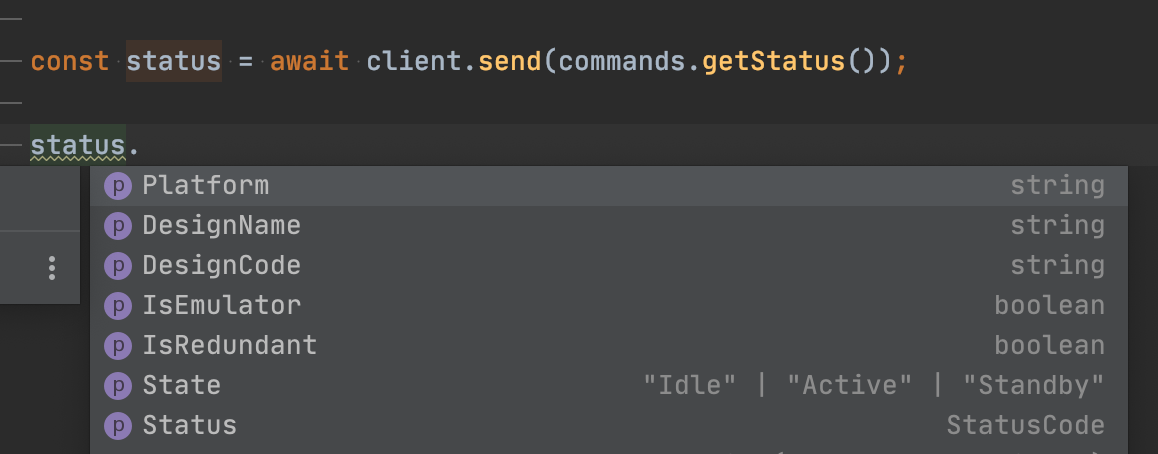qsys-qrc-client v0.1.1
qsys-qrc-client 
An external control client for QSC Q-SYS cores, written in Node.js.
Install
$ npm install qsys-qrc-client zen-observableYou can replace zen-observable with whichever Observable implementation you want. See any-observable.
Usage
import QrcClient, {commands} from 'qsys-qrc-client';
const client = new QrcClient();
client.connect({
port: 1710,
host: '192.168.1.10'
});
async function checkStatus() {
// The send function returns Promises, use the await syntax for synchronous-like code flow.
const status = await client.send(commands.getStatus());
console.log(`${status.DesignName} is running on a ${status.Platform}`);
//=> "My Test Design is running on a Emulator"
}API
client.send(command)
command
Type: Any valid QRC command.
You should generate most commands using the built-in commands object, as described below.
Note: It is not necessary to insert the
"jsonrpc": "2.0"version number in your command. The client will insert it automatically if it is not present.
returns
Type: Promise<Object>
See the documentation for specific return types.
commands.getStatus() / commands.login(username, password) / etc.
The commands object has a number of helper functions to create specific QRC commands. They include type information for the parameters, and the expected return values. Modern IDE's should provide type hints out of the box.

For this reason, it is always recommended you use the commands object to generate the command objects. But you can create commands by hand if needed (i.e. a new command is not yet implemented here).
client.pollGroup(groupId, options)
The only command not sent using client.send(...). It returns an observable that updates every time values in the polling group change.
Before calling, you need to setup the polling group:
await client.send(commands.addNamedControlToGroup('groupId', ['controlName1', 'controlName2']));
const observable = client.pollGroup('groupId', 0.1);
observable.subscribe(data => {
for (const change of data.Changes) {
if(change.Name === 'controlName1') {
// do something with change.Value / change.String / change.Position
} else if (change.Name === 'controlName2') {
// do something with change.Value / change.String / change.Position
}
}
});groupId
Type: string
The groupId of the group of values you want to change. It should already have been setup.
options.rate
Type: number
Default: 0.2
The maximum rate (in seconds) at which to send updates.
options.autoDestroy
Type: boolean
Default: false
If true, then when the last observer unsubscribes from the Observable, the polling group will be automatically destroyed. There are perils with either choice. If you enable autoDestroy, then you must rebuild the polling group to observe those values again, if you do not, then you must remember to destroy the group yourself with client.send(commands.destroyGroup('groupId'))
returns
Type: Observable<AutoPollUpdate>
Observables are a specification for observing changing data. You can find more information at the following resources:
- T39 Spec
- RxJS A popular, full-featured implementation.
- zen-observable A lightweight implementation.
- any-observable Does not provide an actual observable implementation. Use it to specify which Observable implementation you want to use (if
zenorRxJsare installed, they will be found automatically).
Convenience Imports
Rather than importing the entire commands object, you can import just the specific commands you need, and use a slightly less verbose syntax:
import QrcClient, {getStatus} from 'qsys-qrc-client';
// ...
client.send(getStatus());The typescript declarations also export a handful of useful type definitions (used to provide type hints in your IDE), that you can import and reuse.
import QrcClient, {commands, EngineStatus} from 'qsys-qrc-client';
let status: EngineStatus;
// ...
status = await client.send(commands.getStatus());Contributing
Bug Reports and Pull Requests are always welcome. To get started.
1. Install Node.js and git
2. Clone the repository.
3. Run npm install in the cloned directory to pull down all the dependencies.
4. Run npm test to test any changes.
A very simple design file is included in the integration-tests folder, and it is used to test the client against an actual design running in Emulator. It defaults to connecting to localhost but you can change it by putting the connection information in integration-tests/design-location.json. This can be useful if developing on a non-Windows machine.
License
MIT © James Talmage